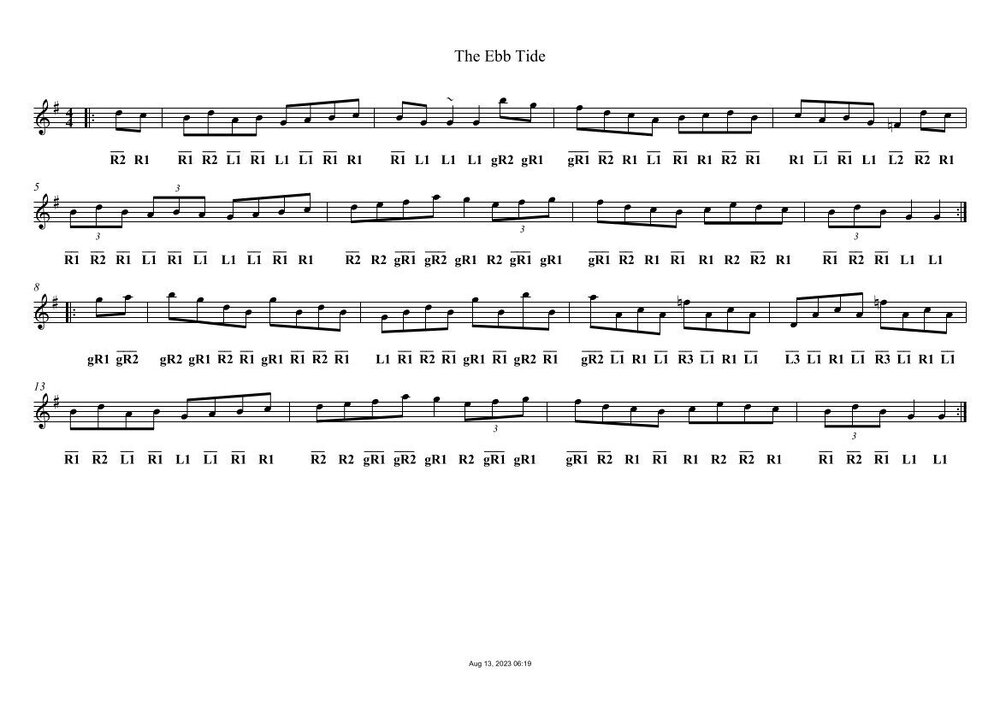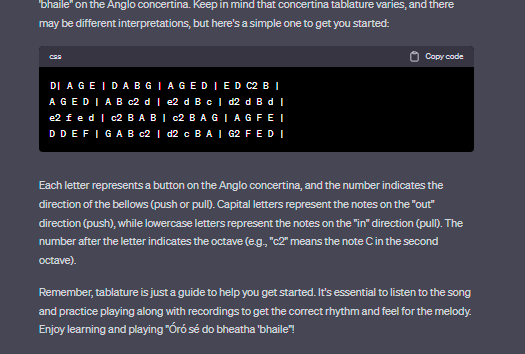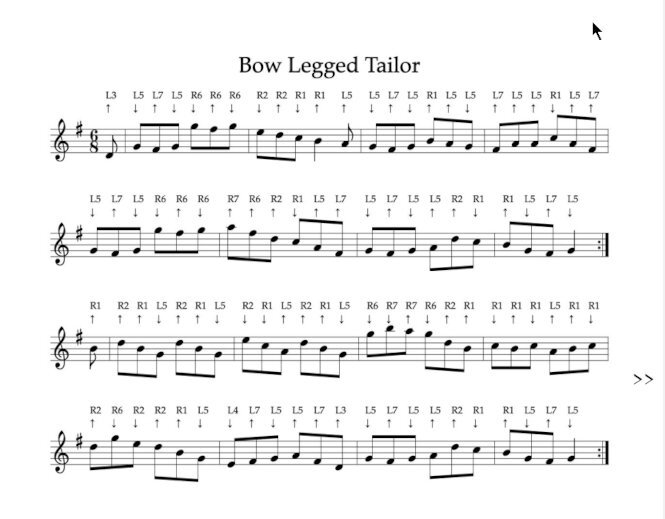-
Posts
1,294 -
Joined
-
Last visited
Everything posted by Roger Hare
-
Nicely done... I never looked at emulating that 'overbar' by stacking a '_' on top of the button name in a text annotation, because at that point, I don't think I'd clocked the fact that it is possible to use two text annotation strings at all! I eventually went with the w: lines because it was easy to find tunes with two lines of lyrics, so I assumed it must be possible to generate two lines of tabs masquerading as lyrics... I've never really decided whether I prefer the 'follow the bouncing ball' tabs produced by the text annotations, or the straight line of tabs produced by the w: lines.
-
[1] Not totally cool. There were a couple of errors/omissions in that diagram. More haste, less speed! As it happens, it didn't affect the results obtained using 'The Ebb Tide' as a test tune... [2] I don't use stacked tab elements in the program which uses 'text annotations', but I do in my program(s) which use an underscore (_) to emulate an 'overbar' for a 'pull'. The 'two-tier-tabs' are constructed using two stacked w: lines. I lay awake at night worrying about trying to centre the underscore over the text component of the tabs. I eventually gave up. The image isn't very good, but I think you can see the 'overbars' aren't quite centred...
-

Is this a good concertina maker?
Roger Hare replied to Sandra A's topic in General Concertina Discussion
I have Marcus No. 453, dating from 2007. A 30-button G/D Anglo which I purchased 2nd-hand from a member here in 2015. I use it for t'Morris. It is my main squeeze. It is an extremely nice instrument... -
Michael Eskin said: > I'd love to see some examples! I interpreted that as a request to see the different button-naming scheme I used when I mentioned that it had only taken a couple of minutes to set it up. The fact that it took such a short time is a reflection of how good ME's program is, rather than anything to do with my tyipgn skllis. It's a modification of the Australian Bush Traditions numbering scheme for C/G concertina. Here it is: This is what I used for the exercise I describe (briefly) below. [In practice, I would use a naming scheme for G/D concertina (which is my main squeeze). The only change to the above figure would be that the 'g's in the bottom row would be replaced by 'd's. It's more verbose - some of the button names are 'longer', but after looking at various button numbering/naming schemes when I started this music lark, this was (and remains) my preferred option.] I generated several tabbed versions of 'The Ebb Tide'. They are included in the attached ABC file. They are: 1. The basic ABC code. 2. The solution produced using ME's default button naming scheme 3. The solution produced using the alternative ABT based button naming scheme illustrated above 4. The default solution 2. converted to a single row of tabs by using a couple of simple global edits within EasyABC. [The overall effect of these edits is to 'collapse' what is effectively a two line tablature into a single line, removing the 'push' character and substituting an alternative 'pull' character. This minimalist single line model using a '^' is what I use in my own tabbing software (see 6.)] 5. The ABT based solution 3. converted to a single row of tabs by using a couple of simple global edits within EasyABC. 6. For comparison, the solution produced by my 'second generation' tabbing program ABCABTTABS. [Here, the tabs are presented as 'dummy lyrics' in ABC w: lines. My 'first generation' program(s) used the 'text annotation' model , but for a number of reasons, I eventually moved to the 'lyrics' model. The actual choice of buttons is different from 2. for the simple reasons that (i) the detailed mapping of notes to button names is different in ME's program and in my program, and (ii) I also make different choice of button when there is more than one option for a given note.] All the solutions look 'different' (to a greater or lesser extent), but as far as I can hear, all produce the same noises when I laboriously go through the tunes note-by-note. I did a lot more messing about with this and came up with a few more interesting observations, but I won't inflict these on a (probably already) bored-to-death audience... ebbtide-short.abc
-

What the heck is this?
Roger Hare replied to SIMON GABRIELOW's topic in General Concertina Discussion
Now there's a word you won't often see in a music-related context (tardigrade too, I guess)? Thank you for brightening the start of my day...😊 There seem to be plenty of toy tardigrades available, if you are that way inclined... The world clearly needs a tardigrade emoji - the best we have so far is this rather unconvincing text representation: උ( ___ )づ ☹️ -

Convert dots to ABC? PDF to ABC?
Roger Hare replied to David Colpitts's topic in Teaching and Learning
I'll add the (strictly, off-topic) rider, that although this thread is about "Convert dots to ABC? PDF to ABC?", sometimes it's a matter of cleaning up existing ABC code so it conforms to 'modern ABC coding standards' (whatever that means). I've found that sometimes, that ABC code is 'spotty', but that the score produced by that code looks fine. In such cases also, I tend to re-write the ABC code working from the score, rather than by attempting to clean up the original ABC code. Seems to work... -

Convert dots to ABC? PDF to ABC?
Roger Hare replied to David Colpitts's topic in Teaching and Learning
I tried this about 4-5 years ago. Unfortunately, the software I used (I can't remember what now) produced a score such that I ended up in a right pickle! "...it would have been easier simply to copy out the score in ABC..." to quote HCJones. This is in fact what I do now... [1] This is pretty close to the rate at which I am able to do this - and I am by no means the worlsd msot copmetetn tpyits... [2] Moi aussi! I finally gave up on MS when version 4 hit the streets. The only features which were of real interest to me for the fairly simple stuff I do were: using the sampled concertina sound font to get decent playback; and concertina tablature (which didn't work). Michael Eskin's tool now provides a very acceptable route to achieving both these goals. I'm surprised you were unable to get EasyABC to run on a Windows 10 machine... -

Is concertina restoration easy?
Roger Hare replied to LilaMable's topic in Instrument Construction & Repair
I only just saw this thread. IMO the book by Dave Elliot is a 'must-have', even if you aren't planning on doing restoration work. It simply tells you everything you ever wanted to know about concertina construction - fascinating stuff. It certainly gave me the confidence to open up my 'tina to do the simple jobs which have been described 'up there' ↑ -
I finally got around to trying out the Anglo fingering generator properly. Disclaimer: I usually use a different tab style and button numbering in my own programs (but I don't think that's relevant in what follows): Using the 'Ebb Tide' example, I found that: Once I had generated the fingering (Wheatstone, cross-row) when I followed the 'Copy to clipboard' and 'Save to file' route described in the documentation, the ABC in the resultant file was corrupted. The up- and down-arrows were replaced with what appear in the on-screen score as a-grave characters. This is illustrated (I hope) below: I just don't have a clue about why this is happening. I'm more than happy to be told that I'm doing something extremely silly...I've included the relevant ABC as an attached file. ebbtide.abc
-
The folkrnn program does a reasonable job of generating 'folk music' automagically (it uses a 'recursive-neural-network trainer'). I visit the site every so often to see what it can produce. I guess it was this program which was at the back of my mind when I queried the 'relevance' of ChatGPT in this area. folkrnn generated this one for me a couple of years ago: I called it '1166 Hornpipe' because it was the 1166th tune generated after the project'went public'. Work on this project continues. I think Bob Sturm is currently based at a university in Stockholm. I had some more up-to-date links, but I simply cannot find them!
-
Thanks for that insight into ChatGPT. I'd assumed there was some human content. It's (almost) a relief to find that that's not the case. I knew nothing about it, and this was my first exposure to anything it had produced. I'm impressed - just not very much...
-
As far as I'm aware, the whole thing was generated by ChatGPT, but I've asked the originator for clarification. (Edit: The originator tells me he doesn't know how ChatGPT produced this result) I couldn't relate the notes to the notes in any of the 6 ABC settings of the tune which I looked at... I also noted the confusion about Push/Pull In/Out Sook/Blaw. Also 'numbers' seem to be used for two different functions... Given the title of the tune, I suspect that this might have been dreamed up by someone who uses 'Irish ABC' (which was discussed somewhere recently - may have been here or melodeon.net). I dunno - it looks like a right mess to me...
-
-
I never thought about the time-line - that would do it! Thanks!
-
Thanks for that! It's (sort of) nice to know that someone else can produce the same result. Obviously, abcjs plus your code is 'smarter' than the EasyABC/Ghostscript combo. Never mind...
-
Wow! that was quick! Ta! I just tried that - nope same result - OK in the on-screen score, nothing in the PDF (I'm pretty sure I tried this before - it was a couple of years ago). I ran out of ideas at that point...☹️ It's not desperately 'important', but it would be nice if I could get this working - I'd be able to add one more tabbing style to my 'repertoire'...😊
-
I've tried adding symbols like this to ABC scripts before. I've tried inserting the symbols directly, and in encoded forms, but I've always had the problem that although the symbols appear in the on-screen score (I'm using EasyABC), they do not appear in the generated PDF. Specifically, I tried adding small square solid and empty 'boxes' in an attempt to add Mick Bramich style tabs, and also the symbols for double-sharp and double-flat. I've always assumed it was something to do with my Ghostscript installation, but I've never bothered pursuing the matter. Any suggestions as to why this should happen are welcome?
-
I have a 26-Button George Jones A♭/E♭ (Salvation Army), and a 26-Button Lachenal C/G. Both are excellent. Both are 6.25 inches across the flats, which is sort of 'standard size for vintage Anglos. 26-buttons is a good compromise if the budget can't stretch to the Full Monty in the form of a 30-button vintage instrument...
-
90% of the PDF files I produce are designed to be actually printed, not read on-screen. There's not much point selecting a link on a piece of paper - it's not going to work, so I tend not to 'highlight' links in my own PDF files. I guess that as a consequence I don't 'expect' to see links highlighted in PDF files in general?
-
I'll try to keep it short! I selected a few tunes at random from your Wheatstone Layout Jigs Tune Book. I created my own ABC version of the tunes. I ran that ABC code through my tab program. I've attached a single example of the results: (1) 'The Bowlegged Tailor' page from your tune book (2) my tabbed version of 'The Bowlegged Tailor' using 'overbar' to indicate 'pull' The fingering looks the same (though the information is laid out differently). I produced the same fingering for all the tunes I tried except for one instance of a repeated accidental (see footnote below) I've been working 'blind' on my tabbing project for some time now, unsure of whether what I'm producing is 'sensible', so it's a great relief for me to finally see some-one else's results which look the same. Hooray!!! ________________________ Footnote There are some important differences between what Michael Eskin is doing, and what I am doing: All my programs are stand-alone, local programs - I don't do web-based programs - I don't know how to...☹️ All my programs are written in the Icon Programming Language (aka Unicon) - I don't know how to program in Java or Python...😊 I only do Wheatstone layout (I don't own a Jefferies), but I do G/D, C/G and Bb/F 'tinas (my main squeeze is a G/D). My program(s) are simple text/string processors, and know nothing about ABC or music theory, so I don't correctly handle (for example) repeated accidentals in the same bar - doesn't happen often, and so far I've fixed it by hand-editing. This is a bug - which so far I have been too bone-lazy to fix!
-
Thanks for all that! That will allow me to run my programs on my copy of a few of the tunes in your tune books and compare the results. Yes, adding a '^' for pull so that the tabs only take up a single line does take more space, on average - but I started out using '^', and have got used to it, although I can also use an 'overbar' over the button number which takes up the same space as the button number on its own (that's why I asked about GC's system - his books use overbars). The slowness I'm seeing is due to the fact that I'm using my small, portable, sloooooow machine this week-end. Everything runs much faster on a more powerful machine... [1] That's exactly what I do - it's (relatively) simple string/text processing, adding the tabs to the existing ABC code before offering the modified result up to the 'real' ABC software to generate the tabbed tune book (usually EasyABC in my case). Thanks again for all that - I'll look at it in detail next week.










